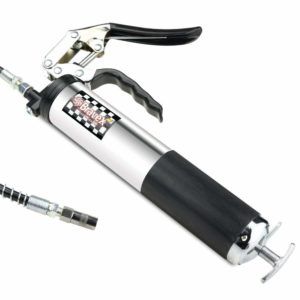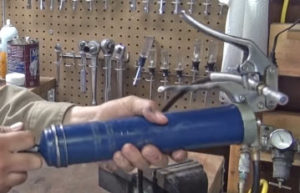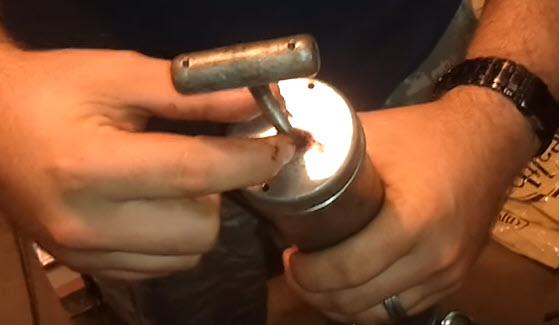For first time users, loading a grease gun can be quite challenging. But even so, the process is quite simple and straight-forward.
So, if you are trying to learn how to do it, then you may need to continue to read on! And if you want to further enhance your grease gun knowledge, this post might help you too!
Grease Guns and Uses
The use of a grease gun in workshops and garages is necessary to provide lubrication to a wide range of projects. The gun is able to release grease or oil through the grease nipple.
This allows easy application of the lubricant to the gaps or openings found on your project.
There are different kinds of grease guns that you can use.  Each of them has their respective methods of operation. For instance, the AK49 Sealey Grease Gun can have a much more complicated loading process than Milwaukee grease guns.
Each of them has their respective methods of operation. For instance, the AK49 Sealey Grease Gun can have a much more complicated loading process than Milwaukee grease guns.
But generally, if you will be loading a grease gun, you have to simply unscrew the grease barrel found on the handle or trigger part of your grease gun.
To pull the grease into the barrel, you have to use the plunger to push down the barrel. You then proceed to pull it up into the barrel. Once your barrel is full of grease, make sure to put it back to your grease gun.
Loading a grease gun is typically done in this way. However, it would be best to read the manufacturer’s instructions as each grease gun model may be unique in terms of loading it.
Using a Grease Gun Properly
In order for you to make the most of your grease gun, you have to find the right grease gun model to serve your purpose. The use of proper output per stroke is necessary. And this is because you will be able to determine how much grease you should add.
Make sure to not mix together different lubricants or grease. Keep in mind that each kind of lubricant requires the use of its own grease gun.
Again, following the instructions of the manufacturer is crucial to using your grease gun the right way.
Kinds of grease guns
• Lever Grease Gun
This is the most common type of grease gun in the market. It is manually operated. This means that you can easily pump the grease out using a hand pump.
• Pistol Grip Grease Gun
Having a pistol grip, rather than using two hands, you can now use one hand to apply grease effectively. There are different variants of pistol grip grease guns. You have the hand- or manual-powered grease gun that is akin to the manual lever grease gun.
- Other Types
There are also pneumatic pistol grip grease guns that utilize compressed air for the application of grease.
Lastly, using a battery-powered cordless grease gun is also apparent today. They are best for projects where you do not have any power source to plug them into or you need not have any cord get in your way.
When Loading A Grease Gun
 Loading a grease gun can be done manually or can be done with the use of a grease cartridge. Using grease cartridges allows doing clean and simple re-lubrication without wasting a lot of your lubricants. Most grease cartridges contain 14 ounces or 400 grams of grease.
Loading a grease gun can be done manually or can be done with the use of a grease cartridge. Using grease cartridges allows doing clean and simple re-lubrication without wasting a lot of your lubricants. Most grease cartridges contain 14 ounces or 400 grams of grease.
Loading Instructions
Here are some tips on loading that you may apply:
1. Have the piston of your grease gun pulled out until it is fully retracted. Its clamping device will automatically lock into place.
2. Unscrew the screws from the grease gun top portion.
3. Remove the foil cover or cap from the grease cartridge.
4. Omit the plastic cap of the other end of your cartridge by cutting it with a knife.
5. Insert the grease cartridge into your grease gun.
6. Screw back on the top portion of your grease gun.
7. Have the automatic clamping device depressed and have the piston pressed into your gun.
8. For entrapped air to escape, make sure to push the ventilation relief valve.
Besides knowing the above basic steps in loading a grease gun, you have to also keep track of the grease condition of your grease gun.
This ensures reliability when it comes to your equipment. By monitoring, you will be able to determine any breakdown of your lubricant.
Furthermore, you can also easily identify possible problems before they take place. This way, you can proceed to do corrective actions before more serious signs of deterioration will show.
Some of these signs include an increase in vibrations, increase in noise, and an increase in operating temperatures.
When you make sure to keep track of the condition of your grease upon application, you will be able to gather crucial information in terms of the quality of your grease. You will also be able to get information on how your grease is performing and how you can perform adjustments on your lubrication intervals.
Analyzing Grease Samples
To make grease analysis of your grease guns more accurate, here are a few pointers to consider if you must remove grease samples from your grease guns.
Sampling containers
Make sure that the material that your container is made of does not make any interaction with the grease material you are sampling.
The most commonly utilized sampling containers are glass bottles or crush-proof plastic bottles. You may use plastic bags. However, they may interfere with the proper analysis of the consistency of your grease sample.
glass bottles or crush-proof plastic bottles. You may use plastic bags. However, they may interfere with the proper analysis of the consistency of your grease sample.
Make sure to avoid the use of absorbent materials such as rags. In terms of size, it should be sufficient enough for you to get the grease sample quantity that you need to make your analysis complete.
Cleanliness
In order for any risk of contamination of your grease sample to be avoided, make sure to take note of the following pointers:
1. Use gloves to not just minimize sample contamination but provide personal protection.
2. Do a visual inspection and cleaning of your sampling equipment and containers.
3. Keep your grease samples clean from dust, dirt, and other contaminants that will affect the results of your analysis.
4. After taking samples, keep your containers properly sealed or capped to prevent further contamination or leaking.
5. In shipping, multiple samples, make sure to seal each of your sample containers in different airtight bags. This ensures the prevention of cross-contamination and leakage. This is a very important factor when you are already loading a grease gun.
Sample labeling
Another crucial element to proper grease sample analysis is to properly label your sample containers. Aside from labeling your components properly, you also have to label each equipment.
You should take samples one at a time and label them quickly after each collection.
Make sure to include the following details:
1. Sample time and date
2. Equipment description
3. Run time of the current grease
4. Name of the baseline grease
5. Contact information, e.g., who took the sample and facility location.
If you want to know more how to load a grease gun, you may want to watch this video:




